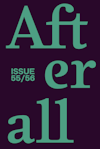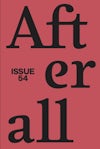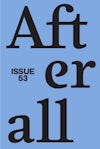
Issue 29
Spring 2012
Issue 29 features deals with the notion of contested and constructed histories. Featuring Moyra Davey, Eugenio Dittborn, Wendelien van Oldenborgh and Dierk Schmidt; accompanying texts look at cinematic space and the public sphere, the ‘Useful Life’ exhibition and R Kelly’s hip-hopera.
Editors: Nuria Enguita Mayo, Melissa Gronlund, Pablo Lafuente, Dieter Roelstraete, Stephanie Smith, Shumi Bose.
Founding editors: Charles Esche, Mark Lewis.
Table of contents
Foreword
Contextual Essays
- Temporality, Sociality, Publicness: Cinema as Art Project – Maeve Connolly
- The Operation Was a Success But the Patient Died – Maija Timonen
Artists
Moyra Davey
- Moyra Davey: Slack Time – Marcus Verhagen
- Pygmalion Desire in Les Goddesses – Isla Leaver-Yap
Wendelien van Oldenborgh
- Interzone: On Three Works by Wendelien van Oldenborgh – Sven Lütticken
- Wendelien van Oldenborgh: ‘The past is never dead. It’s not even past.’ – Emily Pethick
Eugenio Dittborn
- Disarmed and Equipped: Strategies, Politics and Poetics of the Image in Eugenio Dittborn’s Airmail Paintings – Ana Maria Risco
- No Man’s Land Paintings – Willy Thayer
- Correcaminos VII/ Roadrunner VII, 2012 – Eugenio Dittborn
Dierk Schmidt
- Image Leaks: Dierk Schmidt’s Critical Opening of a Permeable Medium – Christian Höller
- Dierk Schmidt: Packing the Hard Potatoes – Lars Bang Larsen
Events, Works, Exhibitions
- ‘Useful Life’: Reflection Among Exhibition Frenzy (Shanghai, 2000) – Philippe Pirotte
- Robert Kelly and Robert McNamara: Extended Narrative versus Data Mining – Liam Gillick
Foreword
Written by Shumi Bose
Perhaps a clichéd observation, but 2011 was a hell of a year, in which time and space seemed to condense current events to a degree of incredible intensity. The first days of the new year seem, as I write in London, to have been met by a mood of abjection rather than the usual jollified optimism, compounded by states of conflict and oppression which have no visible end. Despite unprecedented and innumerable climaxes, every faked orgasm of public synergy and human cohesion — Tahrir Square, #solidarity, the rebel ‘victory’ in Libya — seems to result not in an afterglow but in worryingly incurable and lasting sores.
Overcome by the prospect of examining each global context in its specificity, the generalised phenomena of public frustration, inertia, interregnum and conflict have been balled up into apprehensible parcels and nomenclatures: the Jasmine Revolution ushered in the Arab Spring; the Occupy movement compared neo-samizdat notes along a widening axis from New York to Washington, London, Moscow and beyond. Each instance arises with specific motivations, narrative and histories, but thanks to the broadcast of images and (as has been exhaustively, inconclusively discussed) the ease of participation and interpersonal exchange via technological means, a solidarity binds these disparate situations, making them at once identifiable and indigestible in terms of their particular values. The historiographical achievement of these nomenclatures is the invention of (a) history itself.
The artists included in this issue can be said in a broad sense to address the production or productions of histories, contextualised by interrogations of how these histories are activated and the subsequent impacts of doing so. Eugenio Dittborn’s compositions of images of the face, for example, collaged from printed ephemera, chart not only the history of the gaze and its various motivations but also create their own narratives. Tucked within postal envelopes, his paintings chart a course around the world, producing temporalities that are inscribed, stamped and indelibly folded into the works themselves, gaining affect with each instance of exhibition. The journeys made by the works and their airmailed vehicles almost supersedes the images therein, yet it is critical for the artist to document where those images are culled from, noting the tellings within each telling.
In the teaching of architectural history, one is compelled to take account of the narrative contexts which materialise in built form; indeed, following my experience in architectural education, one could conclude that there is perhaps no such thing as history at all, only a series of pasts which evolve from their own contingencies — history is produced when these ‘pasts’ are perceived from another contingency or context. Dierk Schmidt’s images present histories that are in the process of becoming, and which implicate the viewer in the process of narrative construction. As Christian Höller writes, the absence of a ground in Schmidt’s paintings emphasises the artist’s restraint from assuming a didactic position.
Wendelien van Oldenborgh’s filmic and theatrical works, discussed in this issue by Emily Pethick and Sven Lütticken, also effect a recombinant strategy of historical telling, working through the antimonies of local histories to be further explored and confronted by their own protagonists. Though the works do not promise any ‘fixes’, the interstitial spaces in her installations between image and sound, or film and text, similarly implicate the viewer in the process of historical production, as he or she bears witness to the uncertain narratives of suppressed colonialism, changed labour markets and national identities.
Purchase
The publication is available for purchase. If you would like specific articles only, it is also available individually and to be downloaded as PDFs.
Purchase full publication
Buy via University of Chicago Press
Buy via Central Books
Purchase individual articles
Buy via University of Chicago Press




